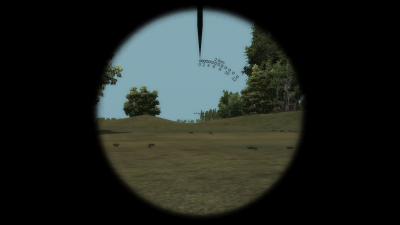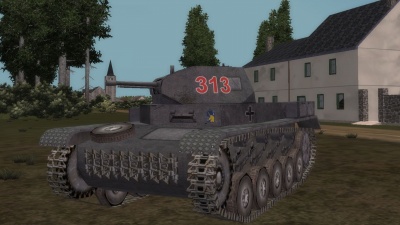Difference between revisions of "PzKpfw II"
(Created page with "=History= {| class="wikitable floatright" | colspan="2" | 400px |- style="background:#666600; color:#fff;" | colspan="2" style="text-align: center;"...") |
|||
| (One intermediate revision by the same user not shown) | |||
| Line 20: | Line 20: | ||
{| class="wikitable floatright" | {| class="wikitable floatright" | ||
| colspan="2" | [[File: | | colspan="2" | [[File:PzKpfw II Optics.png|400px]] | ||
|- style="background:#666600; color:#fff;" | |- style="background:#666600; color:#fff;" | ||
| colspan="2" style="text-align: center;" | '''Main Gun Optics''' | | colspan="2" style="text-align: center;" | '''Main Gun Optics''' | ||
| Line 74: | Line 74: | ||
There is no periscope for the driver and closing the armored view slit prevents any view outside. Crew position 2 is the combination commander/gunner. When buttoned, he’s a gunner - use the numpad “.” or “Del” key to view the gunsight, as is usual in AFVs. When unbuttoned, “commander up” as some refer to it, his binoculars are accessed with the numpad “0” key. The PzKpfw II is not revered or even liked, hardly surprising given its ability to be a tank. It can, with some practice, become a capable anti-aircraft platform against strafing fighters. | There is no periscope for the driver and closing the armored view slit prevents any view outside. Crew position 2 is the combination commander/gunner. When buttoned, he’s a gunner - use the numpad “.” or “Del” key to view the gunsight, as is usual in AFVs. When unbuttoned, “commander up” as some refer to it, his binoculars are accessed with the numpad “0” key. The PzKpfw II is not revered or even liked, hardly surprising given its ability to be a tank. It can, with some practice, become a capable anti-aircraft platform against strafing fighters. | ||
The PzKpfw IIC is available from tier 0. | |||
=Armor= | =Armor= | ||
Latest revision as of 04:25, 21 September 2020
History

| |
| Main Gun Optics | |
| Specifications | |
| Designation | TZF 4 |
| Magnification | 2.5x |
| Field of View | 25° |
The Panzerkampfwagen II was intended to be a stop-gap training platform based upon the earlier and more basic PzKpfw I until the heavier and more advanced PzKpfw III and IV vehicles could enter service in greater numbers. Specifications for the vehicle were issued July 1934; Henschel, Krupp, and Maschinenfabrik Augsburg-Nurnberg AG (MAN) submitted prototypes. The Wehrmacht chose the MAN vehicle and the factory produced an initial batch of 25 PzKpfw II. Ausf A/1.
The vehicle had a crew of three and weighed just over seven and a half tonnes. It was armed with a rapid-fire 2cm Kw.K. 30 L / 55 cannon and a 7,92mm MG 34 coaxial machine gun in the turret. The suspension consisted of six small road wheels grouped in pairs on bogies sprung by leaf springs. A Maybach HL57TR engine drove the front drive sprockets and transmission consisted of a six-speed gearbox, with one reverse gear. Top speed was 40 km/h.
The Ausf. A/2 incorporated a fireproof engine compartment and a large inspection port underneath the engine that gave access to the fuel pump and oil filter. The Ausf. A/3 included a larger radiator along with improved suspension springs.
The Ausf. B welcomed a new Maybach HL62TR engine and stronger mounts for the transmission, engine and final drives. A new drive sprocket was introduced along with wider road wheels, tracks, and return rollers. The suspension was enhanced to increase reliability. Cooling and ventilation of the engine improved and the tank carried a new exhaust muffler.
The PzKpfw II Ausf. C appeared in 1937. Weight increased to nearly nine tonnes. This model tested a radical redesign of the suspension. Five suspension wheels replaced the suspension bogies and four return rollers were added to the side of the hull, along with a new track, sprocket, and idler. Each of the five wheels was individually sprung by quarter elliptic springs.
Engine compartment ventilation and cooling was enhanced. The commander gained a split turret roof hatch.
Despite major work on the suspension and track systems, The Ausf. A, B, and the original C were practically identical. The hulls differed in minor ways, mainly in vision port design. A commander's periscope was added for Ausf. A and a cupola was added for Ausf. B, and all subsequent variants thereafter. Eventually, the vehicle gained an angled nose plate in an attempt to increase protection. The PzKpfw II Ausf. D was introduced concurrently with Ausf. C. It was intended to be a faster version for pursuit and reconnaissance purposes. It incorporated a completely redesigned hull and superstructure and, for the first time, torsion bar suspension. Despite the increased maximum speed of 55 km/h, only 43 Ausf. D and the nearly identical E were produced. They saw action in Poland but by March of 1940 had been wihdrawn or converted to other types, including a flamethrower tank.
Early PzKpfw II's fought in the Spanish Civil War, where they proved vulnerable to the numerous anti-tank guns of the time, a weakness again highlighted during the Polish campaign that opened World War II.
Due to production delays and teething problems with the early PzKpfw IIIs and IVs, the PzKpfw II was deployed in numbers far in excess of original plans. It was used as a main battle tank in Poland, where more than 90% of the German tanks were PzKpfw Is and PzKpfw IIs. Fortunately for the German Army, Poland did not have much of an armor force to resist them with.
Despite its flaws and heritage as a training platform, the PzKpfw II was capable against infantry and light armor. Its 2cm cannon had no high-explosive capacity but proved highly effective against lighter armour and soft-skinned vehicles. It was, however, sadly inadequate for dealing with the heavier enemy vehicles that it would later encounter during the French and Eastern Front campaigns.
By the time of the Battle of France, May 1940, the Germans had tried to remedy the tanks' literal weakness. Most of the available 955 PzKpfw II's earmarked for the invasion had been upgraded with the welding of 20 mm of armour plate to the front of the turret, superstructure, and hulls. It didn't help much. They remained at the mercy of enemy tanks and larger calibre anti-tank guns. In October 1940, an upgrade kit that gave the commander's cupola eight periscopes became available.
The PzKpfw II mit Schwimmkörper (with Flotation Chambers) was designed to take part in a possible invasion of England. Two large pontoons attached to either side of the tank, allowing it to float to England. The tanks were sealed and engine exhaust and cooling were modifed. These tanks were issued to the 18. Panzer-Regiment and would have been the only tanks that could fire during the Channel crossing. With cancellation of the invasion, the regiment and its tanks fought in standard combat against the Soviet Union.
In March 1941, the PzKpfw II Ausf. F was introduced. This was the final model of what was deemed the "normal" PzKpfw II series, and basically incorporated thicker armour throughout. A total of 524 Ausf. Fs rolled out of the factory. Thereafter, small production runs of models tested the vehicle in a variety of roles, all unsuccessful. Ausf. G, H, J, and M all fall into this category. Experiments with models meant for reconnaisance led to the final successful variety of proper PzKpfw II tank, the Ausf. L, called the Luchs (Lynx).
Between September 1943 and January 1944, 104 Luchs variants were manufactured. Daimler-Benz created the design based on a 1938 requirement for increased speed. The Luchs received an official designation of Panzerspähwagen (Armoured Scout Vehicle) II. It weighed 13 tonnes with a crew of four and was capable of a top speed of 60 km/h. It was extremely maneuverable due mainly to its five overlapping road wheels sprung on torsion bars - the same suspension scheme used on the Panther and Tiger series. In total, 800 were ordered, the first 100 armed with the 2cm Kw.K. 30 L / 55 cannon. Later vehicles, designated the Leopard, were to be armed with a 5cm Kw.K. 39/1 L / 60 cannon but none were ever manufactured. Production ceased after the delivery of the first 100.
Despite all its deficiencies, the PzKpfw II amazingly had seen continuous manufacture and service into 1944.
The PzKpfw II chassis was used in many roles during and after the tank's service lifetime. The Marder II (Marten - as in weasel - II) was a PzKpfw II chassis with either a 7,62cm PaK 36(r) or a 7,5cm PaK 40 anti-tank gun. The Wespe was another popular modification, mounting a 10,5cm leFH 18 light howitzer in a superstructure. This was Germany's only widely produced self-propelled 105mm howitzer, with 676 built.
Game Play
The PzKpfw II Ausf. C can be useful if not deployed in a role beyond its thin armor and tiny gun. That said, in circumstances in which this tank has a purpose, that role can better filled by the faster SdKfz 232 armored car, which has the same 20mm main gun and MG 34 machine gun. In Battleground Europe, the poor PzKpfw II is often waits untouched until the supply of SdKfz 232s runs out. It's a reserve light-recon and infantry-suppression tank for use when all the faster, more popular SdKfz 232 lie burning on the battlefield.
Its low profile makes the PzKpfw II an adequate ambush tank, as long as you engage only soft-skinned vehicles, armoured cars, or squishy infantry. Anything tougher will kill you quickly. Your best hope against enemy tanks is to try to hit a tread and track it. Sometimes you can get lucky and disable their main guns, but that’s not a useful tactic at anything but desperation ranges. Some players are exceedingly good at this tactic but it costs them a lot of lives to get that way.
Your commander position is vital. Since this is also your gunner position, it is rarely worth unbuttoning for a better view. If he dies, you have no gunner. Keep the commander down unless you're absolutely sure it's safe to come out.
There is no periscope for the driver and closing the armored view slit prevents any view outside. Crew position 2 is the combination commander/gunner. When buttoned, he’s a gunner - use the numpad “.” or “Del” key to view the gunsight, as is usual in AFVs. When unbuttoned, “commander up” as some refer to it, his binoculars are accessed with the numpad “0” key. The PzKpfw II is not revered or even liked, hardly surprising given its ability to be a tank. It can, with some practice, become a capable anti-aircraft platform against strafing fighters.
The PzKpfw IIC is available from tier 0.
Armor
| Location | Thickness | Angle |
|---|---|---|
| Hull front | 14.5 mm | round |
| Hull sides | 14.5 mm | 0° |
| Hull rear | 14.5 mm | 6° |
| Hull top | 5 mm | 90° |
| Superstructure front | 14.5 mm | 9° |
| Superstructure sides | 14.5 mm | 0° |
| Superstructure rear | 14.5 mm | 9° |
| Superstructure top | 10 mm | 90° to 81° |
| Turret front | 14.5 mm | round |
| Turret sides | 14.5 mm | 22° |
| Turret rear | 14.5 mm | 22° |
| Turret top | 10 mm | 90° to 86° |
| Gun mantlet | 16 mm | round |
